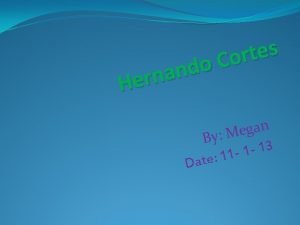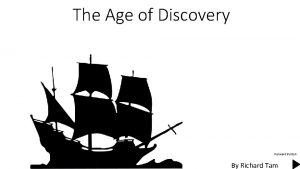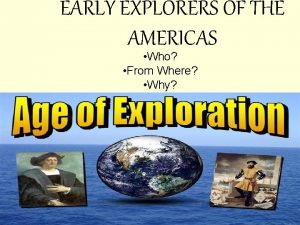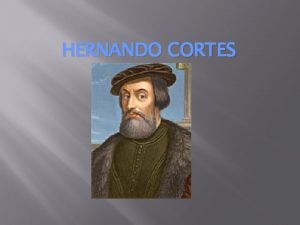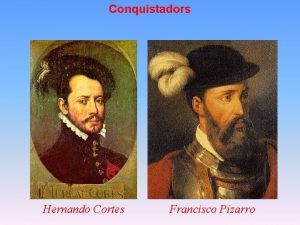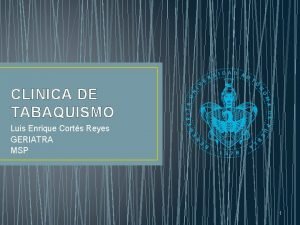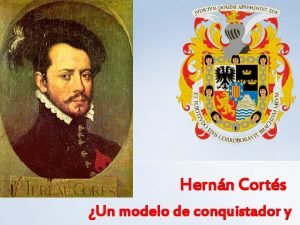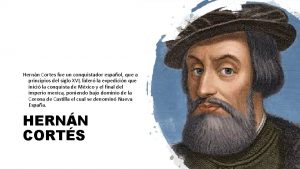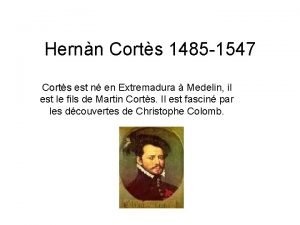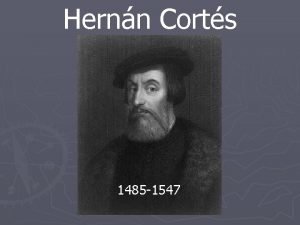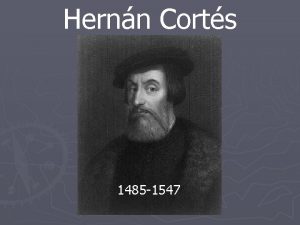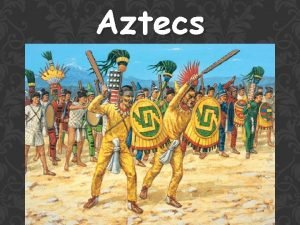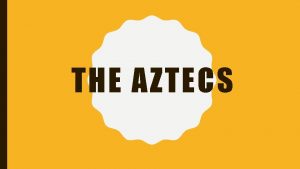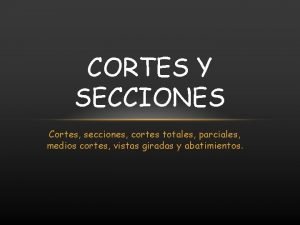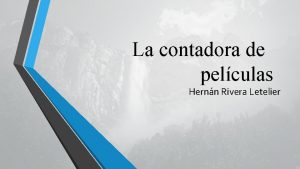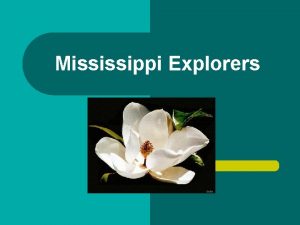CORTES CONQUERS THE AZTECS Hernn or Hernando Corts











- Slides: 11

CORTES CONQUERS THE AZTECS

� Hernán (or Hernando) Cortés was born in 1485 in Medellín, western Spain. He initially studied law but left the university to make his fortune in the Americas. � In 1504 he sailed for Santo Domingo (Dominican Republic), moving to Cuba in 1511 where he assisted Diego Velázquez in his conquest of the island made his reputation for courage and daring. � In 1518 Cortés persuaded Velázquez, who was now governor, to make him commander of an expedition to Mexico. It had only recently been discovered by Europeans and was rumoured to contain great

� Shortly before Cortés set sail, Velázquez, who was now suspicious of his motives, cancelled his commission. Cortés ignored Velázquez and set out. On arrival he established a settlement (now Veracruz) and made local allies.

ENCOMIENDA � Part of first generation of conquerors who began Spanish colonization of the Americas. � Received an encomienda in Cuba � In the encomienda, the Spanish crown granted a person a specified number of natives of a specific community, with the indigenous leaders in charge of mobilizing the assessed tribute and labor. In turn, encomenderos were to take responsibility for their Indian populations, in particular the instruction of the Indians in the Christian faith

ENCOMIENDA � The receiver of the grant was to protect the natives from warring tribes and to instruct them in the Spanish language. In return they could extract tribute from the natives in the form of labor, gold, or other products. In the first decade of Spanish presence in the Caribbean, Spaniards divided up Indians who were worked relentlessly.

� Cortes used a strategy of making allies with other natives that had been forced to live under Aztec rule. He used a native woman, Dona Marina, as an interpreter, who helped Cortes to make native allies. These allies helped Cortes to fight against the soldiers sent by the governor of Cuba. �. �

� � � The major civilization in the region was that of the Aztecs, led by Montezuma II. Cortés headed for the Aztec capital, Tenochtitlán, which was a three-month journey over difficult terrain. It is thought that Cortés’ arrival coincided with an Aztec prophecy about a white-skinned god arriving from the east, which would explain why Montezuma welcomed Cortés and gave him lavish gifts. However, relations quickly deteriorated and, fearing an attack, Cortés took Montezuma hostage, demanding a huge ransom from his people.

� In April 1520, Velázquez sent an expedition to capture Cortés. As Cortés left to fight the expedition, an Aztec revolt began in Tenochtitlán. � Cortés returned and obliged Montezuma to face the crowd, but the Aztec leader was struck by a stone (maybe? ) and died. The Spanish were driven out of the city, incurring heavy losses and giving up most of the gold they had acquired.

� Cortés re-organized his forces and in 1521 returned to Tenochtitlán, which fell after a threemonth siege. A new settlement, Mexico City, was built on the ruins and settled with Spanish colonists, becoming the center of Spanish America. Cortés secured control over Mexico, inflicting great cruelty on the indigenous population. Western diseases such as smallpox also caused huge fatalities.

In 1523 Cortés was named governor and captain general of New Spain. � In 1528, amid Spanish fears that he was becoming too powerful, he was forced to return to Spain He later returned to Mexico, but his powers were significantly limited and his activities monitored. � He continued to explore Central America, hoping to find a strait from the Atlantic to the Pacific. He failed, instead discovering, and naming, California. �

� In 1541, Cortés returned to Spain once again and retired to an estate near Seville where he died on December 2, 1547.
